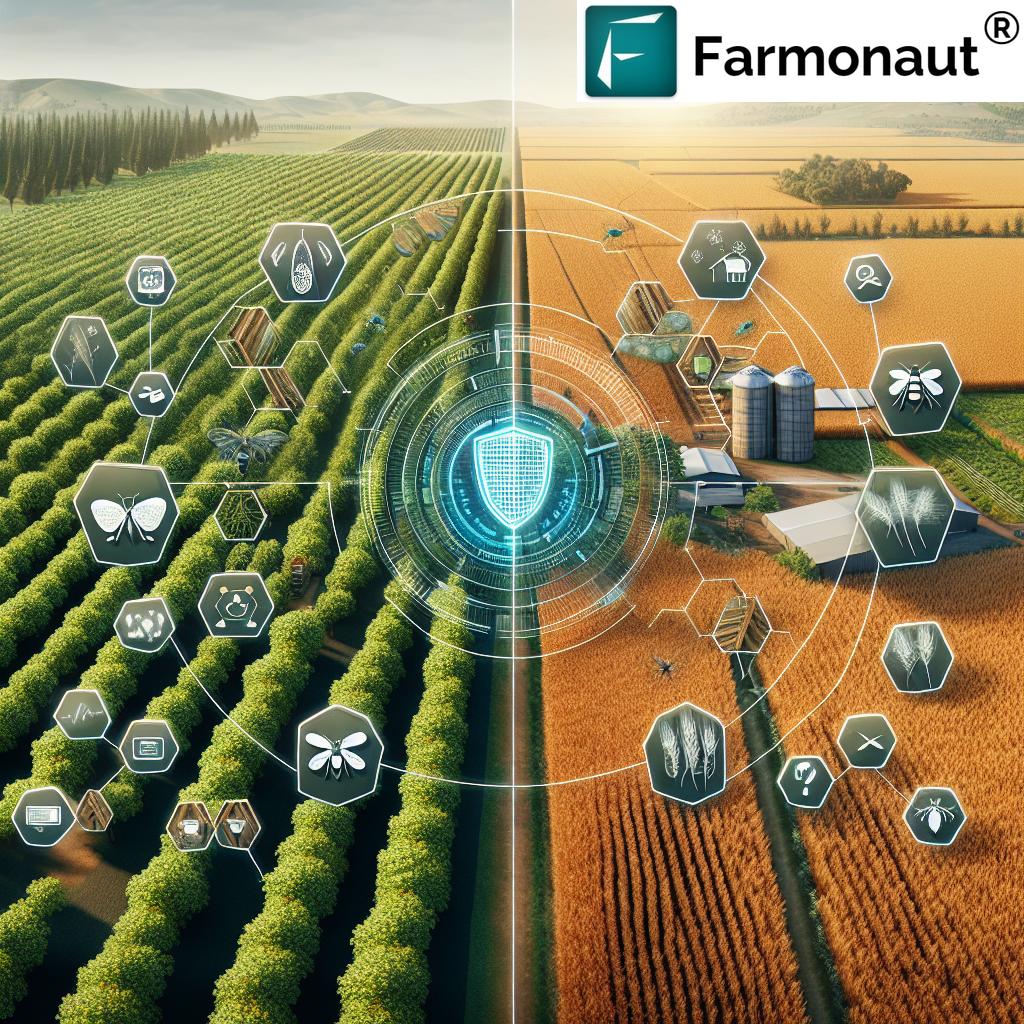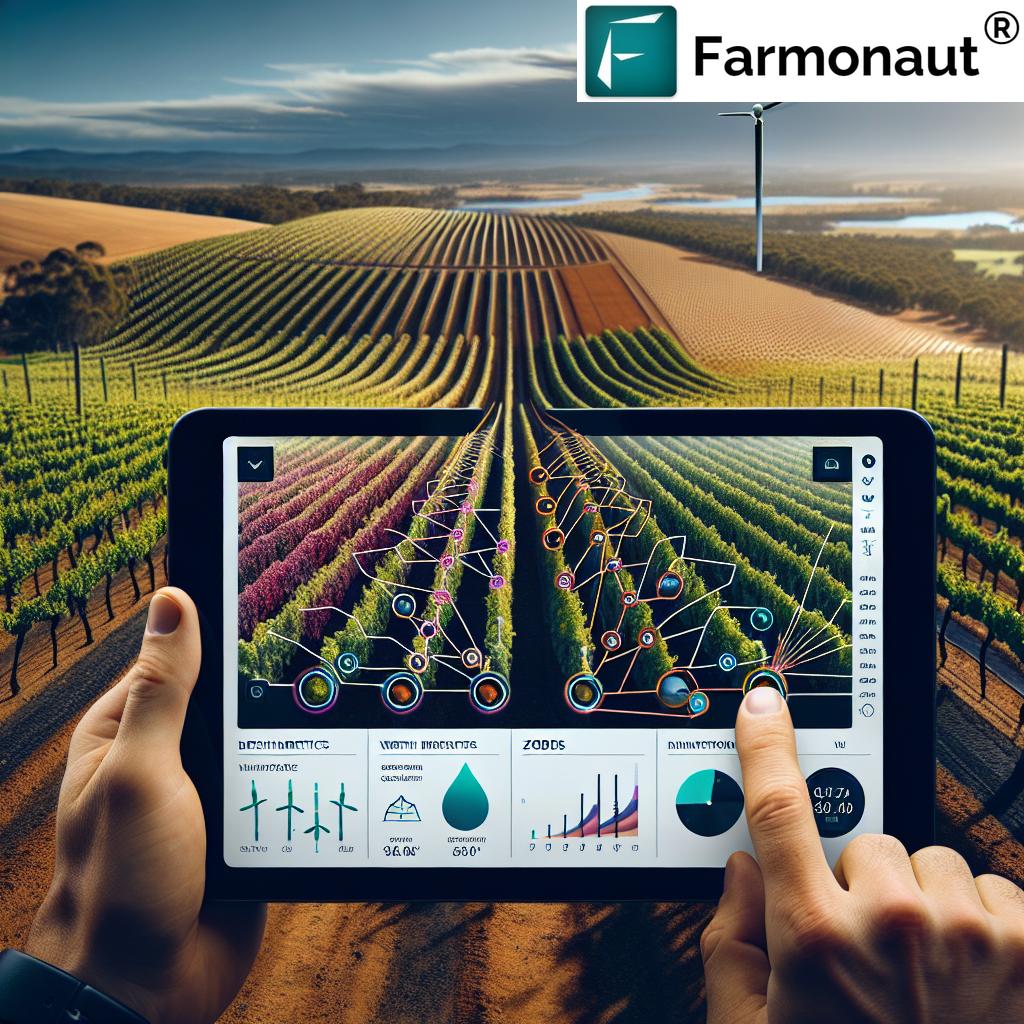Revolutionizing Australian Agriculture: How Farmonaut’s Biosecurity Programs Safeguard Plant Health and Boost Sustainability
“Australia’s National Bee Biosecurity Program protects over 1.7 billion dollars worth of pollination-dependent crops annually.”
In the vast landscape of Australian agriculture, biosecurity plays a pivotal role in safeguarding our crops, livestock, and ecosystems from exotic pests and diseases. As we delve into the world of agricultural biosecurity, we’ll explore how innovative programs and cutting-edge technologies are revolutionizing plant health risk management and boosting sustainability across the nation. At Farmonaut, we’re passionate about leveraging technology to support these crucial initiatives and empower farmers with the tools they need to thrive in an ever-changing agricultural landscape.
The Importance of Biosecurity in Agriculture
Biosecurity in agriculture encompasses a range of measures designed to protect our farms, forests, and food supply from harmful pests, diseases, and other biological threats. These efforts are crucial for maintaining the health of our crops, ensuring food security, and preserving the economic viability of our agricultural industries. Let’s explore some of the key reasons why biosecurity is so vital:
- Economic Protection: By preventing the introduction and spread of exotic pests and diseases, biosecurity measures safeguard Australia’s multi-billion dollar agricultural exports and domestic markets.
- Environmental Conservation: Effective biosecurity helps preserve native ecosystems and biodiversity by preventing the establishment of invasive species.
- Food Security: Maintaining robust biosecurity practices ensures a stable and safe food supply for both domestic consumption and international trade.
- Reputation Management: Australia’s reputation as a provider of clean, green agricultural products relies heavily on our strong biosecurity systems.
At Farmonaut, we recognize the critical importance of biosecurity in agriculture. Our satellite-based farm management solutions complement national biosecurity efforts by providing farmers with real-time crop health monitoring and early warning systems for potential pest and disease outbreaks.

National Biosecurity Programs: Safeguarding Australia’s Agricultural Future
Australia has implemented several national biosecurity programs aimed at strengthening the resilience of our agricultural industries against exotic pests and diseases. These programs are the result of collaborative efforts between government agencies, industry stakeholders, and research institutions. Let’s take a closer look at some of the most impactful initiatives:
1. National Bee Biosecurity Program
The National Bee Biosecurity Program is a cornerstone of Australia’s efforts to protect our vital honey bee populations and the crops they pollinate. This program focuses on:
- Educating beekeepers on best practices for hive management and disease prevention
- Implementing surveillance systems to detect exotic bee pests early
- Developing response plans for potential incursions of harmful bee diseases
- Promoting biosecurity awareness among both commercial and hobby beekeepers
By safeguarding our bee populations, this program indirectly protects billions of dollars worth of pollination-dependent crops, including fruits, vegetables, and nuts.
2. CitrusWatch
CitrusWatch is an innovative biosecurity program designed to protect Australia’s thriving citrus industry. Key components of this program include:
- Early warning systems for citrus canker and other exotic citrus diseases
- Surveillance activities in both commercial orchards and urban areas
- Training for growers and industry personnel on identifying and reporting suspicious symptoms
- Collaborative research efforts to improve disease detection and management strategies
This program exemplifies how targeted biosecurity initiatives can safeguard specific agricultural sectors, ensuring the continued success of Australia’s citrus exports and domestic market.
3. Grains Farm Biosecurity Program
The Grains Farm Biosecurity Program is a vital initiative protecting Australia’s expansive grain industry from exotic pests and diseases. This program focuses on:
- Developing on-farm biosecurity plans tailored to individual grain producers
- Conducting regular surveillance activities to detect potential threats early
- Providing resources and training to help farmers implement best biosecurity practices
- Collaborating with researchers to improve pest and disease management strategies
By safeguarding our grain production, this program plays a crucial role in maintaining food security and protecting one of Australia’s most valuable agricultural exports.
At Farmonaut, we’re committed to supporting these national biosecurity efforts through our advanced satellite-based crop monitoring technology. Our platform provides farmers with valuable insights into crop health, enabling early detection of potential pest and disease issues.
Integrated Pest Surveillance: A Multi-Faceted Approach
Integrated pest surveillance is a critical component of Australia’s biosecurity strategy, combining various techniques and technologies to detect and monitor potential threats to plant health. This comprehensive approach includes:
- Remote Sensing: Satellite imagery and drone technology are used to detect changes in crop health over large areas, potentially indicating pest or disease presence.
- Trapping Networks: Strategically placed insect traps help monitor pest populations and detect new incursions.
- Field Surveys: Regular on-ground inspections by trained personnel to identify and assess pest and disease risks.
- Citizen Science: Engaging the public in reporting unusual plant symptoms or pest sightings through dedicated hotlines and mobile apps.
Farmonaut’s satellite-based crop health monitoring system complements these surveillance efforts by providing farmers with real-time data on vegetation health. Our NDVI (Normalized Difference Vegetation Index) analysis can help detect early signs of stress in crops, which may indicate pest or disease issues.
“The Grains Farm Biosecurity Program safeguards Australia’s $13 billion grain industry from exotic pests and diseases.”
Plant Health Risk Management: Strategies for Success
Effective plant health risk management is crucial for maintaining the productivity and sustainability of Australian agriculture. Key strategies employed in this area include:
- Risk Assessment: Regularly evaluating potential threats and their likely impacts on different crops and regions.
- Preventive Measures: Implementing strict quarantine procedures and import regulations to minimize the introduction of exotic pests and diseases.
- Early Warning Systems: Utilizing advanced technologies and surveillance networks to detect potential threats before they become widespread.
- Rapid Response Protocols: Developing and maintaining emergency response plans to quickly address new incursions.
- Research and Development: Investing in ongoing research to improve pest management techniques and develop resistant crop varieties.
Farmonaut’s AI-powered advisory system, Jeevn AI, supports these risk management strategies by providing farmers with personalized recommendations for crop management, including pest and disease control measures.

Collaborative Efforts: Strengthening Australia’s Biosecurity Network
The success of Australia’s biosecurity programs relies heavily on collaboration between various stakeholders. These partnerships include:
- Government Agencies: Federal and state departments working together to develop and implement biosecurity policies and programs.
- Industry Bodies: Agricultural organizations providing valuable insights and resources to support biosecurity initiatives.
- Research Institutions: Universities and scientific organizations conducting cutting-edge research to improve biosecurity practices.
- Farmers and Producers: On-the-ground implementation of biosecurity measures and participation in surveillance activities.
- Technology Providers: Companies like Farmonaut offering innovative solutions to enhance biosecurity efforts.
These collaborative efforts ensure a comprehensive and coordinated approach to biosecurity, maximizing the effectiveness of Australia’s plant health protection measures.
The Role of Technology in Modern Biosecurity
Advancements in technology are playing an increasingly important role in strengthening Australia’s biosecurity systems. Some key technological innovations include:
- Satellite Imagery: High-resolution satellite data provides valuable insights into crop health and potential pest or disease outbreaks across vast areas.
- Artificial Intelligence: AI algorithms can analyze large datasets to identify patterns and predict potential biosecurity risks.
- Blockchain: Secure, transparent record-keeping for tracing the movement of agricultural products and identifying potential contamination sources.
- Mobile Apps: User-friendly applications that allow farmers and the public to report suspicious plant symptoms or pest sightings quickly.
- IoT Sensors: Networks of connected devices monitoring environmental conditions and providing early warning of potential biosecurity threats.
At Farmonaut, we’re at the forefront of integrating these technologies into practical solutions for farmers. Our platform combines satellite imagery, AI, and blockchain to provide comprehensive farm management tools that support biosecurity efforts.
Best Practices for On-Farm Biosecurity
While national programs and technological solutions are crucial, individual farmers play a vital role in maintaining strong biosecurity practices. Here are some key recommendations for on-farm biosecurity:
- Farm Hygiene: Regularly clean and disinfect equipment, vehicles, and high-traffic areas to prevent the spread of pests and diseases.
- Visitor Management: Implement strict protocols for visitors, including sign-in procedures and designated parking areas away from production zones.
- Quarantine Procedures: Isolate new plant material or animals before introducing them to your main production areas.
- Staff Training: Educate all farm personnel on biosecurity practices and the importance of early detection and reporting.
- Record Keeping: Maintain detailed records of farm inputs, crop rotations, and pest management activities to aid in traceability and risk assessment.
Farmonaut’s platform supports these best practices by providing tools for detailed record-keeping, crop monitoring, and resource management, helping farmers maintain high biosecurity standards.
Public Awareness and Education: A Key Component of Biosecurity
Raising public awareness about biosecurity is crucial for the success of Australia’s plant health protection efforts. Key initiatives in this area include:
- Community Engagement Programs: Workshops, seminars, and public events to educate the general public on biosecurity issues.
- School Education: Incorporating biosecurity topics into school curricula to raise awareness among young Australians.
- Media Campaigns: Utilizing various media channels to disseminate information about biosecurity risks and best practices.
- Traveler Education: Providing clear information at airports and border crossings about the importance of declaring potential biosecurity risks.
By fostering a culture of biosecurity awareness, we can ensure that all Australians play a role in protecting our agricultural industries and natural environment.
The Future of Agricultural Biosecurity in Australia
As we look to the future, several trends and developments are shaping the landscape of agricultural biosecurity in Australia:
- Climate Change Adaptation: Developing strategies to address new pest and disease risks associated with changing climatic conditions.
- Genomic Technologies: Utilizing advanced genetic techniques for rapid and accurate pest and disease identification.
- International Collaboration: Strengthening partnerships with global biosecurity networks to share information and resources.
- Predictive Modeling: Enhancing our ability to forecast potential biosecurity threats using big data and machine learning.
- Sustainable Pest Management: Developing eco-friendly approaches to pest control that minimize environmental impact.
Farmonaut is committed to evolving alongside these trends, continuously improving our technology to support the changing needs of Australian agriculture and biosecurity.
Conclusion: A Sustainable Future Through Robust Biosecurity
Australia’s comprehensive approach to agricultural biosecurity, combining national programs, integrated surveillance, and cutting-edge technology, is setting a global standard for plant health protection. By safeguarding our crops from exotic pests and diseases, we’re not only ensuring food security and economic stability but also promoting sustainable agricultural practices that will benefit generations to come.
At Farmonaut, we’re proud to play a role in this vital effort. Our satellite-based farm management solutions provide farmers with the tools they need to monitor crop health, detect potential issues early, and make informed decisions about pest and disease management. By combining the power of technology with the expertise of our farmers and biosecurity professionals, we’re working towards a more resilient and sustainable agricultural future for Australia.
Together, we can continue to revolutionize Australian agriculture, ensuring that our farms remain productive, our ecosystems stay healthy, and our food supply remains secure for years to come.
Comparison of Key Australian Biosecurity Programs
| Program Name | Target Sector | Key Objectives | Surveillance Techniques | Stakeholders Involved | Estimated Impact |
|---|---|---|---|---|---|
| National Bee Biosecurity Program | Apiculture | Protect honey bee populations, prevent exotic pest incursions | Hive inspections, pest trapping, disease screening | Beekeepers, government agencies, research institutions | Protects $1.7 billion worth of pollination-dependent crops annually |
| CitrusWatch | Citrus Industry | Early detection of citrus diseases, protect citrus production | Orchard surveys, urban monitoring, molecular diagnostics | Citrus growers, industry bodies, government departments | Safeguards Australia’s $850 million citrus industry |
| Grains Farm Biosecurity Program | Grain Industry | Prevent exotic pest incursions, improve on-farm biosecurity | Field surveys, pest trapping, crop health monitoring | Grain farmers, industry organizations, researchers | Protects Australia’s $13 billion grain industry |
Frequently Asked Questions
Q: What is agricultural biosecurity?
A: Agricultural biosecurity refers to a set of measures designed to protect a country’s plant and animal resources from exotic pests, diseases, and other biological threats. It includes strategies for prevention, early detection, and rapid response to potential incursions.
Q: Why is biosecurity important for Australian agriculture?
A: Biosecurity is crucial for Australian agriculture as it helps maintain the health of our crops and livestock, ensures food security, protects our export markets, and safeguards the country’s unique ecosystems from invasive species.
Q: How do national biosecurity programs benefit farmers?
A: National biosecurity programs benefit farmers by providing resources, training, and support to implement on-farm biosecurity measures. They also coordinate surveillance activities and rapid response protocols, reducing the risk of widespread pest and disease outbreaks that could devastate crops and livestock.
Q: What role does technology play in modern biosecurity efforts?
A: Technology plays a crucial role in modern biosecurity by enhancing surveillance capabilities, improving early detection of pests and diseases, and facilitating rapid information sharing. Tools like satellite imagery, AI-powered analytics, and mobile apps are increasingly being used to support biosecurity efforts.
Q: How can individual farmers contribute to national biosecurity efforts?
A: Individual farmers can contribute to national biosecurity efforts by implementing on-farm biosecurity practices, participating in surveillance and reporting programs, staying informed about potential threats, and educating their staff and visitors about the importance of biosecurity.
Q: What is integrated pest surveillance, and why is it important?
A: Integrated pest surveillance is a comprehensive approach that combines various monitoring techniques to detect and track potential pest and disease threats. It’s important because it provides a more complete picture of biosecurity risks, enabling faster and more effective responses to potential incursions.
Q: How does climate change impact agricultural biosecurity?
A: Climate change can impact agricultural biosecurity by altering the distribution and behavior of pests and diseases, potentially introducing new threats to areas where they were previously absent. It also affects crop resilience, making plants more susceptible to certain pests and diseases.
Q: What is the role of public awareness in biosecurity?
A: Public awareness is crucial for biosecurity as it helps prevent accidental introductions of pests and diseases through human activities. Educated citizens are more likely to comply with quarantine regulations, report suspicious plant or animal health issues, and support biosecurity initiatives.
Q: How do biosecurity programs contribute to sustainable agriculture?
A: Biosecurity programs contribute to sustainable agriculture by protecting crop and livestock health, reducing the need for pesticides and antibiotics, preserving biodiversity, and ensuring the long-term viability of agricultural industries.
Q: What are some emerging technologies in agricultural biosecurity?
A: Emerging technologies in agricultural biosecurity include advanced genomic sequencing for rapid pathogen identification, drone-based surveillance systems, IoT sensors for real-time monitoring, and blockchain for improving traceability in agricultural supply chains.
At Farmonaut, we’re committed to supporting Australia’s biosecurity efforts through our advanced satellite-based farm management solutions. Our platform provides valuable tools for crop health monitoring, early detection of potential issues, and efficient resource management, all of which contribute to stronger on-farm biosecurity practices.
To learn more about how Farmonaut can help you improve your farm’s biosecurity and overall management, visit our website or download our mobile app today:
For developers interested in integrating our satellite and weather data into their own applications, check out our API and API Developer Docs.
















